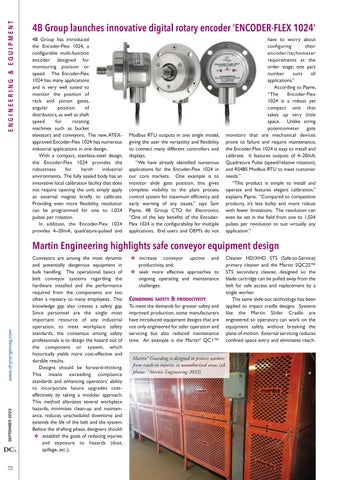ENGINEERING & EQUIPMENT
4B Group launches innovative digital rotary encoder ‘ENCODER-FLEX 1024’ 4B Group has introduced the Encoder-Flex 1024, a configurable multi-function encoder designed for monitoring position or speed. The Encoder-Flex 1024 has many applications and is very well suited to monitor the position of rack and pinion gates, angular position of distributors, as well as shaft speed for rotating machines such as bucket elevators and conveyors. The new, ATEXapproved Encoder-Flex 1024 has numerous industrial applications in one design. With a compact, stainless-steel design, the Encoder-Flex 1024 provides the robustness for harsh industrial environments. The fully sealed body has an innovative local calibration facility that does not require opening the unit; simply apply an external magnet briefly to calibrate. Providing even more flexibility, resolution can be programmed for one to 1,024 pulses per rotation. In addition, the Encoder-Flex 1024 provides 4–20mA, quadrature-pulsed and
Modbus RTU outputs in one single model, giving the user the versatility and flexibility to connect many different controllers and displays. “We have already identified numerous applications for the Encoder-Flex 1024 in our core markets. One example is to monitor slide gate position; this gives complete visibility to the plant process control system for maximum efficiency and early warning of any issues,” says Sam Payne, 4B Group CTO for Electronics. “One of the key benefits of the EncoderFlex 1024 is the configurability for multiple applications. End users and OEM’s do not
have to worry about configuring their encoder/tachometer requirements at the order stage; one part number suits all applications.” According to Payne, “The Encoder-Flex 1024 is a robust yet compact unit that takes up very little space. Unlike string potentiometer gate monitors that are mechanical devices prone to failure and require maintenance, the Encoder-Flex 1024 is easy to install and calibrate. It features outputs of 4–20mA, Quadrature Pulse (speed/relative rotation), and RS485 Modbus RTU to meet customer needs.” “This product is simple to install and operate and features elegant calibration,” explains Payne. “Compared to competitive products, it’s less bulky and more robust with fewer limitations. The resolution can even be set in the field from one to 1,024 pulses per revolution to suit virtually any application.”
SEPTEMBER 2023
www.drycargomag.com
Martin Engineering highlights safe conveyor equipment design
DCi 72
Conveyors are among the most dynamic and potentially dangerous equipment in bulk handling. The operational basics of belt conveyor systems regarding the hardware installed and the performance required from the components are too often a mystery to many employees. This knowledge gap also creates a safety gap. Since personnel are the single most important resource of any industrial operation, to meet workplace safety standards, the consensus among safety professionals is to design the hazard out of the component or system, which historically yields more cost-effective and durable results. Designs should be forward-thinking. This means exceeding compliance standards and enhancing operators’ ability to incorporate future upgrades costeffectively by taking a modular approach. This method alleviates several workplace hazards, minimizes clean-up and maintenance, reduces unscheduled downtime and extends the life of the belt and the system. Before the drafting phase, designers should: v establish the goals of reducing injuries and exposure to hazards (dust, spillage, etc.);
v increase conveyor uptime and productivity, and; v seek more effective approaches to ongoing operating and maintenance challenges.
COMBINING SAFETY & PRODUCTIVITY To meet the demands for greater safety and improved production, some manufacturers have introduced equipment designs that are not only engineered for safer operation and servicing but also reduced maintenance time. An example is the Martin® QC1™
Martin® Guarding is designed to protect workers from reach-in injuries in unauthorized areas (all photos: ©Martin Engineering 2023).
Cleaner HD/XHD STS (Safe-to-Service) primary cleaner and the Martin SQC2S™ STS secondary cleaner, designed so the blade cartridge can be pulled away from the belt for safe access and replacement by a single worker. The same slide-out technology has been applied to impact cradle designs. Systems like the Martin Slider Cradle are engineered so operators can work on the equipment safely, without breaking the plane of motion. External servicing reduces confined space entry and eliminates reach-
